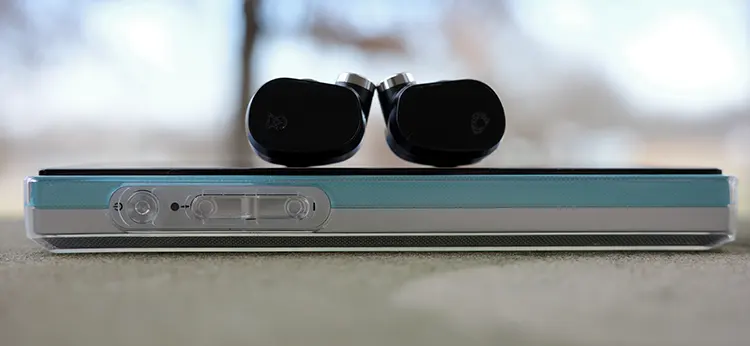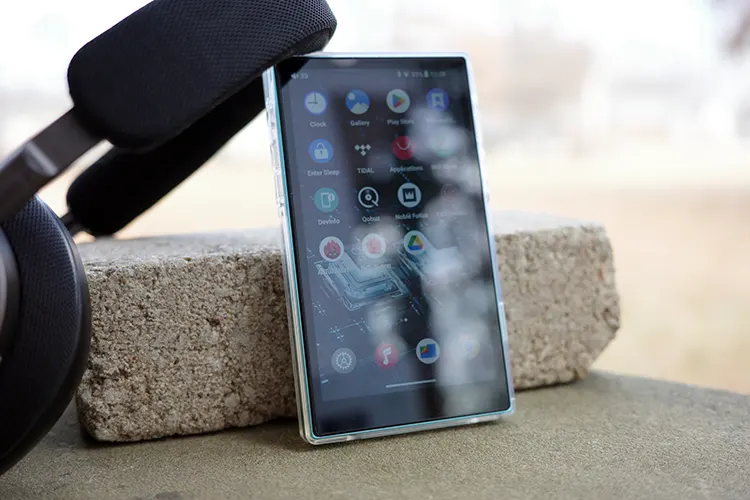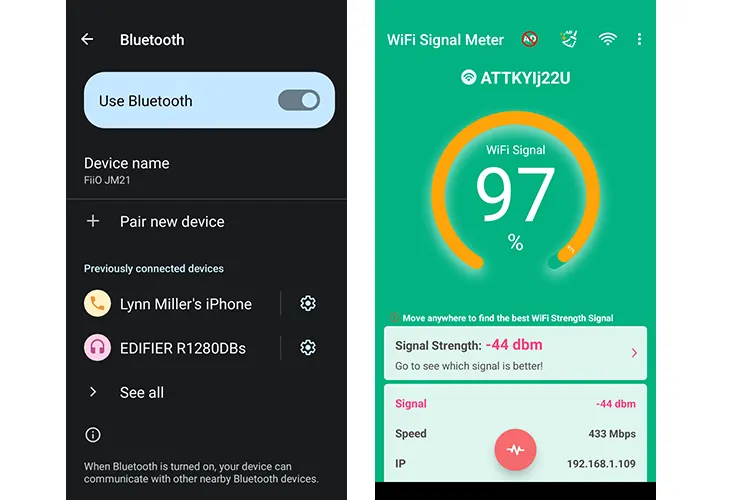Sound Impressions
The following listening impressions were made with the Noble FoKus Apollo (BT and wired), FiiO FT1 Pro, SJY Horizon, Edifier R1280DBs (BT), and a desktop amplifier that doubles as a speaker amplifier (USB-C).
Summary
The JM21 comes across as melodic, with a nearly neutral, slightly bright signature. Even so, the slight brightness does not color the sound at all, allowing the music to carry forth on its own accord.
This may be in the “budget” category of DAPs, but the sound coming forth presents a thoroughly engaging signature, that lacks a small amount in the low-end but carries quality down low.
Notes are consistent with some peakiness, that can be associated with the tuning of certain budget-minded parts.
The bass line is taut, and controlled, but not especially deep, representing the low end in a more refined manner than the HiBy M300; which is a positive.
A lack of sub-bass prevents overlapping bleed into the midrange, which does come across as set slightly behind both ends. That lack of deep-reaching bass runs counter to the top end, which carries some serious push.
Extension is very good, with only some sibilance coming forth when the track leans towards the bright end. This never became a bother, due to the note weight and overall signature that comes across as musical, and dare I say a bit organic.
The differences lie in what the JM21 was paired with. For instance, running the Noble in TWS mode was intoxicatingly good, while using the USB-C presented a calmer, more subdued signature. Almost exactly the opposite of what I was expecting but both represented good feedback.
Coloration
FiiO has its signature, often coming across as extremely accurate to me. The JM21 here carries forth with that schema, to a bit lesser degree. While accurate in signature, the tonality is highly musical, with a smidge of smoother character.
This can come across as warmer, but it isn’t nearly as dark or rich as models such as the Shanling M6 Pro (or later Shanling models). There is a vibrant nature to the top-end, that carries forth through the whole of the signature.
This seeming dichotomy carries a counter of smoothness with the ability to become punchy and vibrant. The smoothness is probably too strong a verbiage, for that carries warmth to a signature that may or may not be the way the FiiO presents itself.
The note weight is just right, with accurate attack and decay down low (even if a bit lacking), which allows for the musical side of the JM21 to showcase, while the extension up top gives space for that musical smoothness to expand.
This adds to the airiness of sound that can be heard, but also the excellent tonality from the overall signature.
Staging & Dynamics
This may be one of the JM21’s biggest panaceas, the smaller soundstage. Some have noted it as “intimate” or “smaller” and I would tend to agree. But not too small that the notes become compressed with a lack of detail or clarity.
The cubic nature of the JM21 presents a good amount of space for the music to stretch out and fill that smaller space. This is actually a benefit since filling in the space fully (without becoming cumbersome) is a positive effect.
That space allows the dynamic nature of the musicality to show forth in that intimate manner, but also to show off good levels of detail, including details on the micro level. This to me is also one of the FiiO trademark sound offerings: excellent micro-detail without becoming too sterile.
Of course, when running the FiiO music app, you can add to those dimensions with the “stereo expansion” dial. This is a good option if you want to expand the space when using the JM21 in either BT mode with speakers or hooked through the USB-C option.
I did enjoy it through BT headphones as well but liked the approach through speakers a bit more.
Synergy
Noise Floor
The background was mostly silent, especially with less sensitive headphones and IEMs such as the Noble FoKus Apollo. The black background helped keep the quiet parts quiet when they should have been.
Much like the R4, more sensitive IEMs such as the Drop x Campfire Audio Dark Star were not silent, but once the music started, the noise was gone. And any between-track noise from the floor was not bothersome unless actively searching.
Super sensitive IEMs may have an issue with the JM21, but once the music starts, that potential problem should fall away.
Power
Even though the JM21 is not the most powerful DAP out, most headphones were fairly easy to drive. Once you go above 300-350Ω, even high gain will not be enough to properly drive headphones of that ilk.
For easier-to-drive units, the 245mW (32Ω) single-ended, and 700mW (32Ω) balanced are more than adequate. Using the Drop x Campfire Audio Dark Star, medium gain and a volume of 35 was plenty to achieve pleasant listening levels.
Pairing Impressions
The Drop x Campfire Audio Dark Star came across as particularly palatable, especially when paired with the solid bass laid down from the IEM.
Response to notes was markedly quick, which I would expect from a FiiO-tuned product, with no sterility. Instead, the pair showed through with a musicality to it, that presented a natural, slightly warm sound due to the Dark Star.
Paired in BT, the Noble FoKus Apollo became my favored pairing. The Apollo carries on the Noble tradition of a musical tune presenting an organic signature without becoming bloated.
Noted for the excellent and detailed response, the pair here did not disappoint. I did have to raise the volume level to 77/120 on the JM21 and nearly max on the Noble to attain adequate listening levels, though.
Running the FiiO FT1 Pro showed the familial synergy between the pair. The FiiO FT1 Pro promotes an exuberant, melodic signature when paired with the JM21 with enough verve to satisfy those who like a speedy signature.
This did not multiply into too much analytically, but rather a preponderance of accurate tonality, an unexpected positive to me. Never lacking in note weight, the pairing did not become saturated with too much thickness, either.
Streaming with the JM21 paired with the Edifier R1280DBs (BT), there was again adequate headroom for a voluminous response.
An excellent choice for small spaces such as apartments, or dorm rooms, the sound was not as vibrant as the headphones/IEMs used above. Using the onboard adjustments of the Edifiers helped.
Wireless Connectivity
Bluetooth
Latency of the 5.0 BT connection was nearly non-existent, with only the recommendation by FiiO not to use this mode for videos. Well, I did and found the low latency quite acceptable.
I did not run a designated BT test other than TWS performance across distances, both streaming and distance from my router. Due to our current situation, we have had to add an AT&T 5G router as our internet connectivity point.
I found the BT range to be quite good ranging from 10m to 15m through a couple of walls built in the early 1860’s. To me anymore, BT performance is a non-factor since all units perform quite well.
WiFi
Using the AT&T router I get anywhere from 2-4 bars consistently living in the country, with speeds ranging from 120mbs to 260mps (lows of about 30mbs-40mbs), which I find quite adequate across the board.
In my current “Listening Lab,” as my wife calls it, we struggle to get 2 bars on WiFi connection no matter where I locate the router upstairs (I am on the opposite side of the house, first floor), resulting in the lower speed mentioned above. Since this is a temporary situation, improving the speed is not in the cards.
This is an excellent test for the WiFi capabilities of devices, and the JM21 came through with flying colors. When within proximity to the router (within a floor and roughly 10m through the floor), I could get close to 96%, which is very good.
In the Listening Lab, I ranged from 46%-81% (with the occasional 26%) depending upon location, without a single drop. Streaming was seamless as a result.
Wired Connectivity
USB-DAC
With a dedicated USB-C that can charge and transmit (not simultaneously), the JM21 presents another worthy option for use.
Connecting the JM21 via USB-C to USB-C to an upcoming review unit, which carries speaker jacks on the back, I could stream without issue.
Running the JM21 at the max 120 volume, the “amplifier” took control without issue. This actually became one of my favored listening options in the LL as a result.





